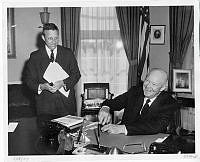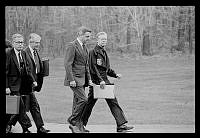James K. Polk

On November 2, 1795, James K. Polk was born in Pineville, North Carolina to Samuel and Jane Polk. The promise of greater economic opportunities and prosperity drew Samuel Polk and his family westward, and they soon settled just south of Nashville, Tennessee. He became a respected community leader, county judge, businessman, and prominent slave owner. Upon his death in 1827, Samuel Polk left behind 8,000 acres of land and fifty-three enslaved people to his wife and ten children.
Although frail as a child, Polk was also intelligent and studious. He graduated from the University of North Carolina in 1818 and returned to Nashville to study law. He soon entered politics and was elected clerk of the Tennessee State Senate, serving until 1822. On January 1, 1824, Polk married Sarah Childress, a woman from one of Tennessee’s most well-regarded families. Sarah was very well educated; she often assisted her husband with speech writing and provided policy advice throughout his political career. The couple did not have any children, but they did raise a nephew, Marshall Tate Polk.
James Polk was shaped by his upbringing on the western frontier and his constant interactions with enslaved people. These experiences framed his attitudes toward slavery and westward expansion, as well as his evolution as a slave owner. Click here to learn more about the enslaved households of President James K. Polk.
In 1823, he was elected to the Tennessee House of Representatives, where he was known for consistently backing the political aspirations of “Old Hickory,” otherwise known as General Andrew Jackson. For this support, Polk gained the nickname “Young Hickory.” In 1825, Polk was elected to the U.S. House of Representatives and in 1835, he became Speaker of the House where he used his authority to strictly enforce a “Gag Rule” barring the discussion of slavery. He served in Congress until 1839 when he was elected governor of Tennessee. As governor, Polk worked to regulate state banks and improve education, before losing his reelection campaign in 1841.
While Polk had a successful career in politics, he also continued to expand his property holdings. To shore up his financial security, he established a plantation called Somerville in southern Tennessee in 1831, becoming an “absentee planter.” Although the plantation enjoyed moderate success, Polk sought additional profits. After Congress passed and President Andrew Jackson signed the Indian Removal Act in 1830, the military forced the Choctaw Nation off their lands in northern Mississippi—one in a series of forced relocations known as the Trail of Tears. Polk joined the rush of speculators to purchase the vacant land. He sold his Tennessee plantation and purchased a new one in Yalobusha County, Mississippi, where Polk’s enslaved workers harvested cotton.
In 1844, Polk set his sights on becoming vice president, expecting former President Martin Van Buren to secure the Democratic Party’s nomination. In a surprising twist, Polk was chosen as the presidential nominee at the convention, largely because of his support for “Manifest Destiny” and expanding the United States’ territorial holdings. The “dark horse candidate” faced off against Whig candidate Henry Clay and won, becoming the eleventh president of the United States in 1845.
After successfully renegotiating the Canadian boundary to the 49th parallel with Great Britain, Polk instigated the Mexican-American War, a two-year conflict stemming from the 1845 annexation of Texas. In 1846, Polk sent American diplomat John Slidell to secretly negotiate a dispute over Texas’ boundary claims and purchase the territories of New Mexico and California for up to $30 million. When the Mexican government turned Slidell away, President Polk ordered American troops under General Zachary Taylor to move into and occupy disputed territory, inciting the conflict with Mexico.
At the conclusion of the conflict, the United States successfully acquired more than 500,000 square miles of Mexico’s land holdings including present-day California, Utah, Nevada, Arizona, and New Mexico. President Polk publicly supported the expansion of slavery into these territories, while employing enslaved individuals at the White House, including Henry Carter, Jr. and Elias Polk. Polk also made secret purchases of thirteen enslaved children through an agent during his presidency. These individuals were sent to work on his Mississippi plantation.
Polk retired after one term, but he did not enjoy the comfortable existence he had arranged at his Nashville home, Polk Place. On June 15, 1849, less than four months after leaving office, the former president succumbed to a cholera outbreak in Nashville.































